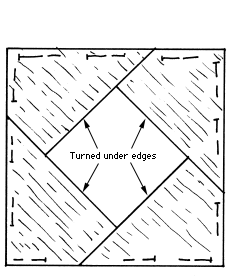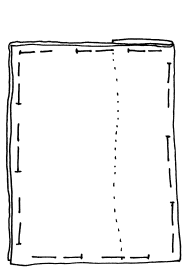Guide to Make Patchwork Pillow
Do you like or want to make patchwork? if you want to make patchwork follow this guide to make patchwork pillow. It will show you how to make a cushion with patchwork technique, combining diferent fabrics.
Patchwork usually combines fabrics with different colours, but in this case you will only need white fabrics; wild silk, muslin fabric, and some ribbons, etc.
If you enjoy sewing you will love this project, follow all the steps to make your own patchwork below:
What you need to make patchwork pillow?
- 3 squares, every 38 x 38 cm, of textured white cotton material (the one applied here has hard woven lines and there is a really pale cream line in it).
- 8 x 38 cm white cotton backing fabric
- 2 pieces white cotton backing fabric, each 25 x 38 cm
- 24 x 24 cm white wild-silk type fabric
- 24 x 30 cm white muslin fabric
- 24 x 30 cm white medium-weight white iron-on Vilene interfacing
- 3 metres (12 mm wide) white looped-edge ribbon (Offray)
- Pearly white flat sequins: Gütermann Col.1085
- Silvery white seed beads: Gütermann Col.1016
- 1 skein white tapisserie wool: Anchor Col. 8004
- Small amount of bright white double knitting wool (brighter than the tapisserie wool)
- White sewing thread
- 35 x 35 cm cushion pad
What you do to make patchwork pillow?
- Bend one of the squares of textured material in half diagonally. Finger push along the fold to set the crease. Open out the square and bend from corner to corner along the different diagonal. Finger push to crease. Cut on the folded diagonal lines to make four triangles. Along the longest position of every triangle turn 2 cm to the wrong position to neaten. Finger press and pin to hold. Set one triangle in every corner of the square of backing material, overlapping the triangles where they meet at the mid-point of each side of the backing square (see picture no 1). Pin around the sides of the square to hold.
- Carefully to mistake the little square of silky material into the centerof gap formed by the triangles, gathering the borders under the neatened borders of the triangles. Pin on these neatened borders to hold the silky material in position. Cut 4 lengths of the ribbon (30 cm in length) and pin these 1.5 cm away from the turned below borders and parallel to them, gathering the ribbon ends under the material to neaten (see picture 2).
- Use white sewing thread to machine straight stitch close to the turned-under edges of the corner triangles and then similarly stitch close to the edges of the strips of ribbon, to secure the ground fabrics of the design in position. If preferred, this stitching could be worked neatly by hand.
- Print and accurately trace the leaf motif (picture 3) onto an sheet of paper, allowing enough space to reposition it, and trace it again to produce a four-leaf motif. Similarly, trace a single leaf and stalk. Cut out the paper templates that you have made. [When printed, the design should measure 11.5 cm from leaf tip to the centre of the four-leaf motif - the point where the central veins cross - if necessary enlarge or reduce to size.]
- Position the four-leaf template on the white muslin fabric, leaving enough fabric to cut out three individual leaves, then pin in place. Adding a narrow 0.5 cm turning allowance all around the motif, cut out the four-leaf shape. Position and cut out three individual leaves, adding the allowance as before.
- Using the paper templates, from the interfacing cut out to size (i.e. without 0.5 cm allowance) the four-leaf motif and three separate leaves. Place the interfacing glue side down onto the corresponding muslin motif. Following the manufacturer's instructions, bond the muslin and interfacing together.
- Using very sharp-pointed scissors, snip into the corners of the turning allowance on the muslin. Carefully and neatly fold the turning to the wrong side. Using white sewing thread and tiny hand stitches that do not show through to the right side, secure the turning on the wrong side of the leaf shapes. Reserve the three single leaves to decorate the back of the cushion.
- Place the four-leaf motif centrally on the silky square. Pin to hold and stitch in position using white sewing thread, making your stitches as small as possible around the edges of the motif.
- Using the creamy white tapisserie wool, work a line of neat and even back stitches along the centre of each leaf and then work side lines (veins) across one half of each leaf. Similarly, using the bright white knitting wool, work the lines (veins) across the other half of each leaf. Refer to the leaf pattern to help you work the lines of back stitches, but work them freely without drawing on the white fabric.
- Using the white sewing thread (doubled for extra strength), stitch sequins and beads in a random scattering over the silky fabric. Use a single bead to secure each sequin (see Picture 4). This completes the cushion face.
- Take one of the remaining squares of textured fabric and one of the white backing pieces. Place the textured square on top of the backing fabric, matching up the sides and folding the excess at one end to the wrong side. Finger-press along the fold and then pin the layers of fabric together around their edges (see picture 5). Pin a length of ribbon close to the folded edge. Pin a second length parallel to the first but 7 cm away from it. Machine straight stitch in white along each edge of the two lengths of ribbon.
- Arrange and pin the three leaf motifs along the 7 cm gap and invisibly stitch them into position. Decorate each leaf with lines of back stitching to match the four-leaf motif on the cushion front.
- Place the remaining white textured square over the remaining white backing fabric, folding the excess textured fabric to the wrong side. Pin the layers together around their edges to hold.

Picture 1: Overlap triangles to form a continuous pattern.

Picture 2


Picture 4: Attaching sequins and beads: bring the needle and thread (use doubled for strength) to the surface. Pass through the hole of a sequin, thread on a bead and then take the needle down through the sequin and fabric.


Picture 5 : Fold top fabric over backing fabric and pin as shown.
To finish
- Place the cushion front on a clean flat surface with right side uppermost.
- Position the section of the cushion back with the leaves right side down on the cushion front, matching up the raw edges. Add the second piece of the back of the cushion so that its folded edge overlaps the other piece of the back, lining up the three raw edges with those of the cushion face (see picture 6). Pin together around the edges.
- Working with a 1 cm seam allowance, machine straight stitch around all four sides.
- Snip away any excess fabric across the corners and then carefully turn the cushion cover through to the right side, gently easing it into shape.
- Place a cushion pad inside the completed cover.

Picture 6 : Make the cushion..
Suggestions
- Take the idea a step further by working the same design in black on black or any other colour.
- Keep the white theme, but alter the design.



